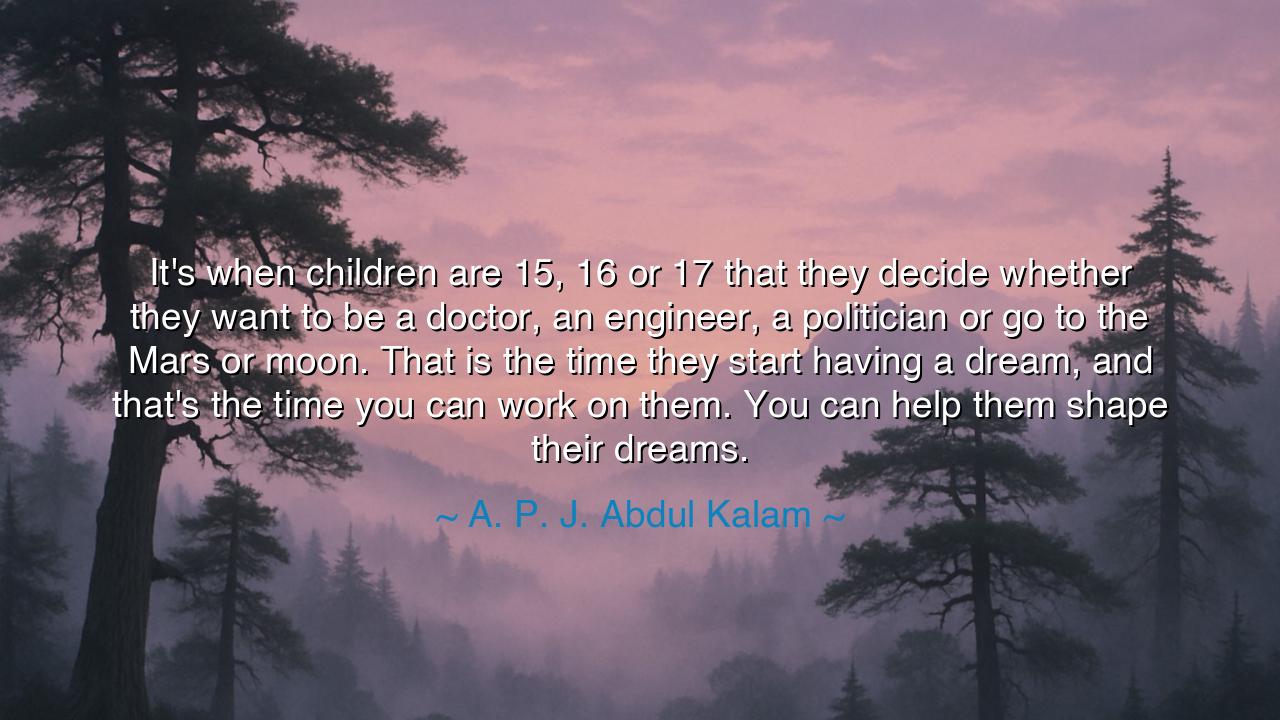
It's when children are 15, 16 or 17 that they decide whether they
It's when children are 15, 16 or 17 that they decide whether they want to be a doctor, an engineer, a politician or go to the Mars or moon. That is the time they start having a dream, and that's the time you can work on them. You can help them shape their dreams.






“It’s when children are 15, 16 or 17 that they decide whether they want to be a doctor, an engineer, a politician or go to the Mars or moon. That is the time they start having a dream, and that's the time you can work on them. You can help them shape their dreams.” — These words, spoken by A. P. J. Abdul Kalam, the visionary scientist and beloved teacher of India, echo with the wisdom of one who understood the sacred power of youth. He who was called the People’s President did not see young minds as vessels to be filled, but as flames to be kindled. In this saying, he reminds us that the teenage years — those tender, turbulent, radiant years — are the forge where the soul’s dreams are shaped, where destiny first whispers its call.
To the ancients, youth was the dawn of life — a sacred moment when the spirit, still unburdened by cynicism, gazed upon the world with wonder and dared to imagine greatness. Kalam saw in the young not confusion, but potential; not weakness, but the fire of discovery. The ages of 15 to 17 are not merely numbers — they are a passage between innocence and purpose, when the mind begins to hunger for meaning, when a single word of encouragement can ignite a lifelong pursuit. It is the time when the dream, fragile yet fierce, begins to take form. And in that sacred season, the role of mentors, parents, and teachers becomes divine — for they hold the tools to shape futures and nations alike.
Kalam himself was once such a dreamer. Born in humble circumstances in Rameswaram, he gazed at the sky as a boy and dreamed of flight. In a time when such visions seemed impossible for a child of his background, he dared to believe. And when a teacher once spoke to him of aerodynamics and rockets, that small spark became a blazing purpose. Years later, that dream led him to design India’s missiles, to touch the stars of science, and to guide a nation toward self-reliance in space and defense. His life itself is proof of his words: the seed of greatness is planted in youth, and it blooms when nurtured with faith and guidance.
This quote, then, is not merely about education — it is about awakening. Kalam calls upon the elders of the world to recognize that dreams are the lifeblood of progress. When the young are encouraged to dream of Mars, medicine, or leadership, they begin to see the possible in the impossible. The dream gives direction; it transforms energy into effort, imagination into achievement. But when a child’s dream is dismissed or ignored, something sacred within them dies. The teacher who believes, the parent who listens, the mentor who guides — these are the unseen architects of tomorrow’s civilization.
There is an ancient story of Aristotle and Alexander. The philosopher saw in his young pupil not just a prince, but a potential conqueror of knowledge and lands. By nurturing Alexander’s curiosity, he transformed a restless youth into a visionary leader. The same truth resounds in Kalam’s words: when guided by wisdom, the youthful dreamer becomes the creator of destiny. Every generation must pass its torch to the next, not with control, but with faith — faith that their dreams may travel farther than ours ever did.
Yet, this shaping of dreams must be done with tenderness. For at fifteen, the mind is impressionable, the heart vulnerable. It must be fed not with fear, but with hope; not with conformity, but with imagination. To guide the young is not to command, but to inspire. The wise do not dictate the dream — they help it unfold, as sunlight coaxes a flower to bloom. Each young soul must find their own path: some will reach the stars, others will heal the earth, others will build bridges between minds. All are sacred when guided by purpose.
The lesson, then, is clear: honor the dreamers of youth. Do not mock their wonder, nor smother their questions. Instead, listen, encourage, and guide. Tell them that no dream is too vast, no goal too distant. For the world advances only when the young dare to go beyond the known. If we help them shape their dreams, we shape the future itself — brighter, wiser, and filled with possibility.
So remember the teaching of A. P. J. Abdul Kalam: when the child begins to dream, the work of the mentor begins. To shape a young mind is to touch eternity. For the world belongs not to those who command it, but to those who dream of what it can yet become — and strive, with love and courage, to make it real.






AAdministratorAdministrator
Welcome, honored guests. Please leave a comment, we will respond soon